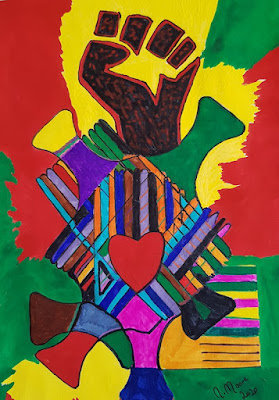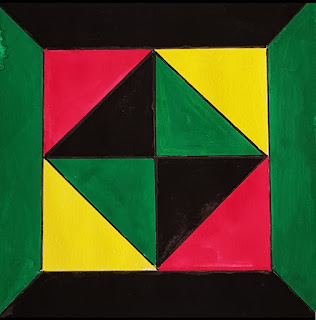 |
| Hair Power (2020) ⓒ Nicole Moore |
2020
Mixed Media Abstract Realism
8.25 x 11.7 inches
Today is World Afro Day, (WAD) founded on 15 September 2017, by London-based Michelle De Leon, as a platform for celebrating afro excellence and ending afro hair discrimination. WAD is about the education and empowerment of people with afro hair.
To mark WAD 2022, I am sharing Hair Power, a piece of artwork I made as a result of being invited to participate as a panel speaker at a WAD event on 15 September 2020: 'Hair Today/Wear Tomorrow' where I read poems from my independently published anthology Hair Power Skin Revolution (2010).
 |
| Nicole Moore (1970s) |
As a reference for Hair Power, I used my own afro comb for the design by literally drawing around it, thereby using the comb—a symbolic icon—as a geometric measuring tool in a similar way a ruler was used for the marking and positioning of the design. I then lightly sketched and interspersed the remaining elements of the composition at different angles to display the afro combs as a central focused and unified entity. I used Crayola Super Tips and a black V7 Hi-Tecpoint pen for fine lines.
The aim was to create an illusion of a three-dimensional form and shape by layering and overlapping the afro combs, placing them in an asymmetrical stylised arrangement to arrive at a more dynamic outcome, one that included a sense of rhythm of combs spiralling that led the viewer's eye to view the artwork at a focal point of visual unity and to then look elsewhere.
The idea of a Black Power fist evolved over a period of a few days. It made sense to incorporate this part of the image at the top to make a connection, not just with the power of afro hair, but with the history of how the Black Power fist became an icon overnight, when Tommie Smith and John Carlos protested on the podium at the 1968 Olympics, while the US national anthem was playing, refusing to salute while raising their fists up as they bowed their heads to symbolise Black Power.
 |
| Nicole Moore (2010) |
The rich vibrant background colour scheme of gouache paint in red, yellow, and green was added to make Africentric diasporic cultural connections with the Rastafari flag, my Guyanese heritage, the history of wearing my hair in dreadlocks between 2006 and 2012, and wearing my hair in an Afro in the 1970s. These interconnections supported the artistic process. I also documented the art method by taking photos at different stages and by making audio recordings to capture my thoughts and feelings.
Afro Hair Discrimination
Afro hair discrimination is particularly rife, especially but not exclusively, in schools all over the UK, and continues to affect Black pupils—girls and boys—who wear afro hairstyles such as dreadlocks, braids, afros, and cornrows. This is where the risk of damage to Black pupils is greatest because not only do they have to deal with everyday racism in education, but they also have the double whammy of being discriminated against if they wear their afro hair in a natural style.
Black pupils who wear their afro hair natural at school are seen as a 'problem' to be fixed and punished. This has a lot to do with the way that the British education system's historical ideology of fitting in with whiteness perceives the Black child — as a Black body only, without any humanity and respect. If children enter the education system and the first reaction they get is that their hair is unacceptable, then this can jeopardise the young person's self-esteem, confidence and education; it can become a life-long sentence.
Furthermore, it is not just children and young adults on the receiving end of afro hair discrimination. Black adults wearing their afro hair natural are also perceived as 'unprofessional' in the corporate workplace. And even though the Equality Act 2010 protects individuals on the grounds of nine "protected characteristics" including race, age, religion and sexual orientation, the Act, excludes hair from being named as a "protected characteristic".
Education should first and foremost be about learning and empowering young people so that they move forward in society as best they can, seizing ambitious opportunities to develop their true potential. Education should not be about singling out Black pupils because they want to wear their afro hair in natural styles.
Socially Acceptable
Thankfully, afro hair is becoming more socially acceptable. For example, the British advertising industry is working towards a more inclusive and diverse representation of the Black image in its adverts and narratives. Images that portray Black people wearing their afro hair in dreadlocks, afros, and braids are becoming the norm. This means Black imagery of afro hairstyles has slowly but surely broken through the mainstream media.
World Afro Day is part of a growing and developing movement that is working with schools in the UK to turn things around so that schools are educated on the intricacies of afro hair and how important it is not to single out their Black pupils and make an example of them because they choose to wear their afro hair natural but instead encourage them to celebrate their natural locks with pride.
Comments welcome!
Thanks for reading.



